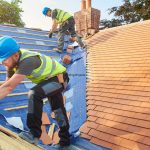
How Roof Design Affects Your Home’s Energy Efficiency
When it comes to energy efficiency in a home, the roof design plays a crucial role. A well-designed roof can significantly influence heating and cooling costs, indoor comfort, and overall energy consumption. Understanding how roof design affects energy efficiency can help homeowners make informed decisions during construction or renovation. This article explores the key aspects of roof design and its impact on energy efficiency.
Comprehensive guides :
Roof Shape and Pitch
The shape and pitch of a roof are fundamental factors that determine how well it manages heat and light.
Steep vs. Flat Roofs: Steep roofs tend to shed water and snow more efficiently, reducing the risk of leaks and damage. They also promote better airflow in the attic, which helps regulate temperatures. In contrast, flat roofs can absorb more heat and may require additional insulation to maintain energy efficiency.
Gable vs. Hip Roofs: Gable roofs have two sloping sides, allowing for better ventilation and reducing heat buildup in the attic. Hip roofs, which slope on all sides, offer stability and are less prone to wind damage, but they can create less attic space for ventilation.
Roof Material
The materials used for roofing significantly affect a home’s energy efficiency.
Reflective Materials: Roofs made of reflective materials, such as metal or light-colored shingles, can reflect sunlight and reduce heat absorption. This is particularly beneficial in warmer climates, where a reflective roof can lower cooling costs significantly.
Insulation: The type of insulation used in the roofing system also plays a critical role. Materials such as spray foam insulation can provide excellent thermal resistance, keeping the home cooler in the summer and warmer in the winter.
Green Roofs: Vegetated or green roofs, which involve planting vegetation on top of a waterproof membrane, can provide natural insulation and reduce heat absorption. They also contribute to improved air quality and stormwater management.
Ventilation
Proper ventilation is essential for maintaining energy efficiency in homes.
Attic Ventilation: A well-ventilated attic helps regulate temperature and moisture levels. It prevents heat buildup in the summer and reduces the risk of ice dams in the winter, which can cause damage to the roof and increase energy costs.
Passive Ventilation: Incorporating passive ventilation systems, such as ridge vents, soffit vents, and gable vents, allows hot air to escape while drawing in cooler air. This natural airflow helps maintain a comfortable temperature inside the home without relying heavily on air conditioning.
Orientation and Overhangs
The orientation of the roof can influence energy efficiency by maximizing natural light and minimizing heat gain.
Sunlight Exposure: Roofs oriented towards the sun can benefit from passive solar heating, reducing heating costs in colder months. However, excessive sunlight can lead to overheating in summer. Strategic placement of overhangs can provide shade, reducing direct sunlight on windows and cooling needs.
Overhangs: Roof overhangs play a significant role in blocking direct sunlight during summer while allowing it in during winter when the sun is lower in the sky. This design feature can help regulate indoor temperatures and reduce reliance on heating and cooling systems.
Roof Color
The color of the roof can have a significant impact on energy efficiency.
Light vs. Dark Colors: Light-colored roofs reflect sunlight and can help keep homes cooler in warm climates, thus reducing air conditioning costs. Dark roofs absorb more heat, which may be advantageous in colder climates, but can lead to higher cooling costs in warmer months.
Impact of Roof Design on HVAC Systems
The design of the roof can also affect the efficiency of heating, ventilation, and air conditioning (HVAC) systems.
Reduced Load: A well-insulated and ventilated roof can reduce the load on HVAC systems, allowing them to operate more efficiently. This can lead to longer equipment life, lower energy bills, and improved indoor air quality.
Zoning: Roof designs that incorporate zoning principles, where different areas of the home can be controlled separately, can optimize energy use. This allows for better temperature regulation and reduces energy consumption.
Sustainable Design Considerations
Incorporating sustainable design practices into roof design can further enhance energy efficiency.
Solar Panels: Installing solar panels on the roof can generate renewable energy, significantly reducing reliance on grid electricity. The angle and orientation of the roof are crucial for maximizing solar panel efficiency.
Rainwater Harvesting: Roof designs that facilitate rainwater harvesting can reduce water usage and contribute to energy savings by minimizing the need for irrigation.
FAQs
How does roof pitch impact energy efficiency?
Roof pitch affects airflow and heat management. Steep roofs promote better ventilation and snow shedding, reducing heat buildup. Flat roofs may require additional insulation to maintain energy efficiency, especially in warmer climates.
What roofing materials are best for energy efficiency?
Reflective materials, such as light-colored shingles or metal, help reduce heat absorption. Insulated roofing systems, like spray foam, provide excellent thermal resistance, keeping your home cooler in summer and warmer in winter.
How can proper ventilation improve my roof’s energy efficiency?
Proper ventilation helps regulate attic temperature and moisture, preventing heat buildup and ice dams. Systems like ridge and soffit vents promote natural airflow, reducing reliance on air conditioning and enhancing overall energy efficiency.
Conclusion
The design of your roof has a profound impact on your home’s energy efficiency. From shape and materials to ventilation and color, each element plays a crucial role in regulating temperature and reducing energy consumption. By considering these factors when designing or renovating your roof, you can enhance your home’s energy efficiency, reduce utility costs, and contribute to a more sustainable environment. Investing in a well-designed roof is not just about aesthetics; it’s a critical step toward achieving a comfortable and energy-efficient home.





